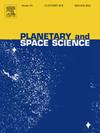On the formation of satellites in dense solid-particle disks
IF 1.7
4区 物理与天体物理
Q3 ASTRONOMY & ASTROPHYSICS
引用次数: 0
Abstract
Single massive satellites are of great observational interest, as they can produce prominent and potentially detectable signatures. For terrestrial planets and super-Earths, giant impacts in the late stages of formation may generate dense self-gravitating disks — favourable environments for the formation of such satellites. Motivated by this, we explore satellite formation in dense solid-particle disks through three-dimensional N-body simulations, focusing on the effects of disk mass and the surface density exponent (). Our results reveal significant variability in the masses and configurations of satellites formed under identical disk parameters, highlighting the stochastic nature of the process. Higher disk masses and flatter surface density profiles favour the formation of more massive satellites. Disks with masses above 0.03 planetary masses typically yield a single dominant satellite, while those between 0.003 and 0.03 tend to form two-satellite systems. On average, the mass of the largest satellite scales linearly with the initial disk mass, in agreement with analytical predictions. We estimate that a disk with a minimal mass of 0.03 planetary masses around a 1.6 Earth-mass planet orbiting a Sun-like star could form an Earth–Moon-like system detectable by telescopes with a photometric precision of 10 parts per million – a level achievable by the James Webb Space Telescope.
稠密固体颗粒盘中卫星的形成
单个大质量卫星具有很大的观测价值,因为它们可以产生明显的、潜在的可探测信号。对于类地行星和超级地球,在形成后期的巨大撞击可能会产生致密的自引力盘——这是形成此类卫星的有利环境。受此启发,我们通过三维n体模拟研究了致密固体颗粒盘中卫星的形成,重点研究了盘质量和表面密度指数(β)的影响。我们的结果揭示了在相同的圆盘参数下形成的卫星的质量和结构的显著变化,突出了这一过程的随机性。更高的圆盘质量和更平坦的表面密度剖面有利于形成更大质量的卫星。质量超过0.03行星质量的圆盘通常会产生一个主要的卫星,而质量在0.003到0.03之间的圆盘往往会形成两个卫星系统。平均而言,最大卫星的质量与初始圆盘质量呈线性关系,这与分析预测一致。我们估计,一个最小质量为0.03行星质量的圆盘,围绕着一颗1.6地球质量的行星,围绕着一颗类似太阳的恒星运行,可以形成一个类似地月的系统,用望远镜可以探测到,光度精度为百万分之十——詹姆斯·韦伯太空望远镜可以达到这个水平。
本文章由计算机程序翻译,如有差异,请以英文原文为准。
求助全文
约1分钟内获得全文
求助全文
来源期刊

Planetary and Space Science
地学天文-天文与天体物理
CiteScore
5.40
自引率
4.20%
发文量
126
审稿时长
15 weeks
期刊介绍:
Planetary and Space Science publishes original articles as well as short communications (letters). Ground-based and space-borne instrumentation and laboratory simulation of solar system processes are included. The following fields of planetary and solar system research are covered:
• Celestial mechanics, including dynamical evolution of the solar system, gravitational captures and resonances, relativistic effects, tracking and dynamics
• Cosmochemistry and origin, including all aspects of the formation and initial physical and chemical evolution of the solar system
• Terrestrial planets and satellites, including the physics of the interiors, geology and morphology of the surfaces, tectonics, mineralogy and dating
• Outer planets and satellites, including formation and evolution, remote sensing at all wavelengths and in situ measurements
• Planetary atmospheres, including formation and evolution, circulation and meteorology, boundary layers, remote sensing and laboratory simulation
• Planetary magnetospheres and ionospheres, including origin of magnetic fields, magnetospheric plasma and radiation belts, and their interaction with the sun, the solar wind and satellites
• Small bodies, dust and rings, including asteroids, comets and zodiacal light and their interaction with the solar radiation and the solar wind
• Exobiology, including origin of life, detection of planetary ecosystems and pre-biological phenomena in the solar system and laboratory simulations
• Extrasolar systems, including the detection and/or the detectability of exoplanets and planetary systems, their formation and evolution, the physical and chemical properties of the exoplanets
• History of planetary and space research
 求助内容:
求助内容: 应助结果提醒方式:
应助结果提醒方式:


